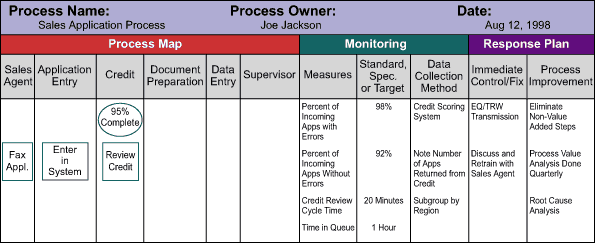
Look around a company that has been using Lean Six Sigma for awhile. Listen to the kinds of stories that circulate. Which people are mentioned the most? Likely it is the Black Belt who led a project that saved a million dollars or created a whole new market for a product. Or the Master Black Belt who solved a technical issue that had been bothering the company for years. Undoubtedly the senior executive or Champion who oversees the Six Sigma program or individual projects is getting a lot of credit too.
All well and good. No need to begrudge those people their hard-earned Six Sigma status. But examine more closely the companies which are sustaining the gains from their Lean Six Sigma efforts, and one finds unsung individuals who also are doing an exceptional job – the process owners.
A process owner is the person who has the authority to determine how a process operates, and the responsibility to make sure it continues to meet customer and business needs today and into the future. This is a role that no company can afford to overlook if it wants to be world class.
Responsibilities of an Effective Process Owner
A good process owner knows his or her process like an auto mechanic knows cars. A process owner:
1. Knows what is critical about the process. The process owner must understand what about the output is important to customers of the process and to the business, and must have a thorough understanding of how his or her process fits into the overall scheme of the business:
- What processes feed into this process?
- What processes rely on output from this process?
- What is strategically important about this process? Does it contribute to or support a particular product or service? Does it affect overall operational effectiveness?
2. Monitors process performance with data. This must include both input/process metrics (because they are early predictors of performance) and output measures. In many cases, the process owner is monitoring data compiled by process operators and summarized into a dashboard (Figure 1).

3. Makes sure the process is documented, and that the documentation is used and updated regularly. Some organizations have run into trouble by allowing too much variation in how a process 1s performed – each employee having their own particular way of doing business. It is up to the process owner to champion an effort to identify the best-known process methods, particularly what parts of the process must be standardized so that output quality and service to customers do not suffer. Those best-known methods must be documented (with flowcharts and other visual displays) and referenced constantly. (Work groups that do not refer to process documentation usually show more erratic performance than those that do.) If the process changes for good reason, the documentation must change as well.
4. Makes sure a process management (or control) plan is in place. (Figure 2)
- Everyone in the work area knows how the process should operate.
- Everyone knows how to detect signs of trouble and what to do if a problem appears (often called a response plan).
- Process data is charted and posted in the work area, visible to all.

5. Holds regular reviews. There are two levels of review that the process owner must lead:
- A process review – Is the process performing as required by customers and the business? Are the input and output metrics “in control” and “capable”? If not, what are the biggest issues? Who should be assigned to a project team to attack those problems?
- A process management review – Is the method of reviewing, monitoring, and managing the process working? If not, what needs to be improved?
6. Makes sure that any improvements identified through projects are incorporated and maintained in the process.
7. Provides linkage to customers, suppliers and other processes. A process owner is the critical link between a process and the rest of the world – both inside and outside the company. More so than any other individual working on the process, the process owner needs to maintain connections in all directions – with supplier processes, with customer processes, with processes above and below in the corporate hierarchy.
8. Makes sure that process operators have the training and resources to do their jobs well. A good process owner is in many ways a servant to the process operators. It is his or her job to figure out what the operators need in order to do their jobs well, and to keep getting better. Those needs can include appropriate training, materials and information.
Conclusion: Not Glamorous, but Critical
Though the words authority and responsibility are used to describe a process owner’s role, that does not mean process owners should be dictators. Quite the contrary, good process owners know they will get better results if they include all, or a representative subset, of the process operators to help manage the process. But it is the process owner’s decision about when, why and to what extent to share authority. Many process owners use a tool such as a RACI (Responsible, Accountable, Consulted, Informed) chart to capture the levels of decision-making authority and involvement for different individuals or groups.
There is no glitz or glamour to process ownership. Much of the work is mundane and routine. But process owners play a critical role in determining whether a company’s processes hum along, or stumble and falter. It is the vigilance of process owners that is establishing a new baseline of improved performance in effective Six Sigma organizations.